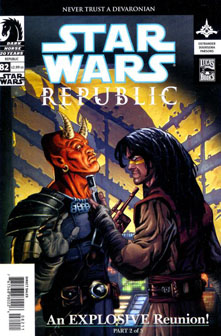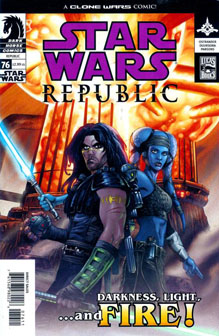In late 2004, after Quinlan Vos is welcomed back by the Jedi Council and Anakin seemingly kills Asajj Ventress in “Republic” Issue 71, Dark Horse’s Clone Wars saga split into three parts leading up to the May 2005 release of “Revenge of the Sith.” Obi-Wan and Anakin hunt Ventress in the “Obsession” miniseries, “Episode III” villain General Grievous is explored in his eponymous miniseries and Quinlan’s story continues in the last dozen issues of “Republic.”
Appropriately, Quinlan’s final nine issues (three of these last 12 issues, which I’ll get to later in this post, focus on other characters) have a similar feel to the emotional arc of “Revenge of the Sith.” “Trackdown” (72-73) and “Siege of Saleucami” (74-77) mark a grand final victory by the Republic over the Separatists in the Outer Rim, just as Obi-Wan feels he lands the final blow when he kills Grievous in “Episode III.” Quin, Aayla and Tholme take the lead against a Separatist army of Morgukai clones led by Count Dooku’s lieutenants Sora Bulq and Tol Skorr. Writer John Ostrander continues to portray Quin and Aayla’s relationship similarly to Angel and Faith from the “Buffy” saga, as they take turns helping each other through their inner turmoils.
Aayla: “I made a promise to you once – as you were there for me when I was lost in the darkness, I will be here for you.”
Except for the fact that we know what happens next, Issue 77 has a happy ending: Quin vows to leave the Jedi Order and start a family with his girlfriend Khaleen after the war winds down; Tholme will get to spend more time with his loved one, the ageless Jedi T’ra Saa; and Aayla accepts her next generalship, leading clones on Felucia. Because this issue came out in July 2005, two months after “Revenge of the Sith’s” release, we know Aayla is going to be killed by her men on Felucia when Order 66 comes down. As it turns out, this is the last time we see Aayla in the comics, except for flashbacks.

“The Hidden Enemy” (81-83), then, takes on a fatalistic tone from the get-go. I almost had a lump in my throat seeing Luminara get gunned down, hearing the fateful news about Aayla and Bariss on Felucia, and seeing Quinlan flee his former soldiers into the Kashyyyk jungle Rambo-style. (Yes, “Republic” tells us Bariss is killed along with Aayla on Felucia, which doesn’t jibe with “Clone Wars” Season 5, where Bariss was imprisoned by the Republic.)
Not only is this Quin’s final arc, it’s also the final “Republic” arc. Ostrander didn’t have enough time to bring back all the old favorites. Although Dark Horse did allow the “Republic” Clone Wars saga to go until February 2006, it ultimately wanted to move on to post-“Episode III” stories. As such, I feel like the Dark Woman vs. Aurra Sing rivalry was never resolved, and while A’Sharad Hett (now sans Tusken Raider mask) does fight in the Siege at Saleucami, his character arc became watered down.

But Ostrander does bring back Villie in “The Hidden Enemy,” and he is in fine form – always doing things for money, but gradually beginning to consider Quin a friend until he ultimately saves Quin’s life in the Kashyyyk jungle. The young Wookiee who sees Villie as an uncle is a humorous touch. And Quin holding his baby, Korto Vos (named after Quin’s alias from when he was infiltrating Dooku’s gang) on the final panel puts a satisfyingly tidy bow on “Republic.”
Ostrander also nicely wraps up the arc of Sagoro Autem in “Loyalties” (78). We met Autem as a Coruscant Guard in Issues 46-48. Disgruntled with the Republic, he returned as a mercenary in “Jedi: Shaak Ti,” but then popped up as a Republic fleet commander (along with a young Jan Dodonna, in a nice nod to “A New Hope”). Before giving Autem a happy ending where he is rescued from the Emperor’s assassins by his formerly estranged son, “Loyalties” delivers a horrifying glimpse into the Empire’s new reality:
Autem: “No, Dodonna. I commanded the fleet at Saleucami, but the real hero was a Jedi –”
Dodonna: “Who has since been discredited. You are now the hero of Saleucami, just as I am retroactively the hero of Randili. There are no Jedi heroes. That is the new order of things.”
Along with Issue 78, two other issues of “Republic” take place after the Republic turns into the Empire. In retrospect, Issues 79-80 (“Into the Unknown”) should’ve been the first two issues of “Dark Times,” which launched in late 2006 but still continued the “Republic” numbering system in the fine print on the inside flap. “Into the Unknown” is written by primary “Dark Times” writer Randy Stradley (under the pseudonym Welles Hartley) and illustrated in the painterly style of Douglas Wheatley (pencils) and Chirs Chuckry (colors). It introduces “Dark Times” main characters – and new allies in this age of the Empire – Dass Jennir, a Jedi, and Bomo Greenbark, a Nosaurian Separatist who defended his planet against Republic incursion.
“Into the Unknown” also shows us an alternate approach to dealing with the new Imperial reality. Master Hudorra sends his teenage Padawan, Noirah Na, off to fend for herself with a small bag of money, and dumps both of their lightsabers down a garbage chute. Then he declines Jennir’s request for help.
Hudorra: “For now, I am going to take the advice I gave the girl. Perhaps, if the order one day rises from the ashes, I will once again take up my lightsaber. Until then, the galaxy will have to get along without my sword.”
I consider this to be a pathetic stance. For one, Hudorra fought in a war when the conflict was unclear, and now he’s declining to fight when the conflict is crystal clear. Secondly, the galaxy needs freedom fighters in order to rise from the ashes. Biding one’s time – rather than suicidally rushing a group of clones, as one unnamed Jedi does in this story — may be prudent in some cases, but excusing oneself to the sidelines is a vote for the status quo. On the other hand, Hudorra’s choice to go off and become a gambler rather than a warrior stands as an alternate option throughout Dennir’s and Greenbark’s against-long-odds fight for justice in “Dark Times.”
Perhaps due to the assist from Wheatley or the freedom of writing under a fake name, “Into the Unknown” is a deeper yarn than what we usually get from Stradley. At this point, it’s too soon to say that the Stradley/Wheatley team could someday stand toe-to-toe with the gold standard of Ostrander/Duursema, but their work here is a respectable start to a new chapter of “Star Wars.”

